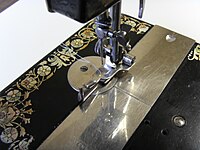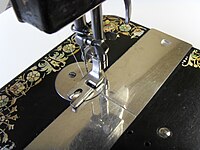
Singer Corporation is an American manufacturer of consumer sewing machines, first established as I. M. Singer & Co. in 1851 by Isaac M. Singer with New York lawyer Edward C. Clark. Best known for its sewing machines, it was renamed Singer Manufacturing Company in 1865, then the Singer Company in 1963. The global headquarters are based in Nashville, Tennessee. Its first large factory for mass production was built in 1863 in Elizabeth, New Jersey.

A sewing machine is a machine used to sew fabric and materials together with thread. Sewing machines were invented during the first Industrial Revolution to decrease the amount of manual sewing work performed in clothing companies. Since the invention of the first sewing machine, generally considered to have been the work of Englishman Thomas Saint in 1790, the sewing machine has greatly improved the efficiency and productivity of the clothing industry.
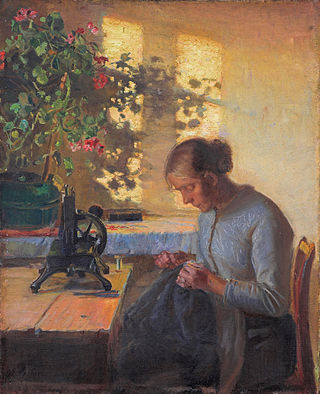
Sewing is the craft of fastening or attaching objects using stitches made with a sewing needle and thread. Sewing is one of the oldest of the textile arts, arising in the Paleolithic era. Before the invention of spinning yarn or weaving fabric, archaeologists believe Stone Age people across Europe and Asia sewed fur and leather clothing using bone, antler or ivory sewing-needles and "thread" made of various animal body parts including sinew, catgut, and veins.

A hem in sewing is a garment finishing method, where the edge of a piece of cloth is folded and sewn to prevent unravelling of the fabric and to adjust the length of the piece in garments, such as at the end of the sleeve or the bottom of the garment.

An overlock is a kind of stitch that sews over the edge of one or two pieces of cloth for edging, hemming, or seaming. Usually an overlock sewing machine will cut the edges of the cloth as they are fed through, though some are made without cutters. The inclusion of automated cutters allows overlock machines to create finished seams easily and quickly. An overlock sewing machine differs from a lockstitch sewing machine in that it uses loopers fed by multiple thread cones rather than a bobbin. Loopers serve to create thread loops that pass from the needle thread to the edges of the fabric so that the edges of the fabric are contained within the seam.
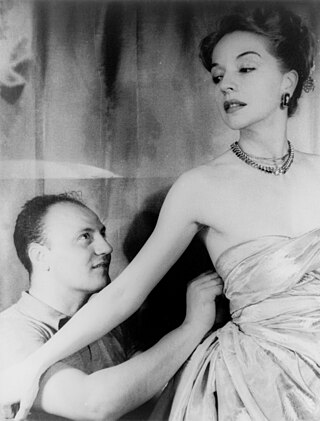
A dressmaker, also known as a seamstress, is a person who makes clothing for women, such as dresses, blouses, and evening gowns. Dressmakers were historically known as mantua-makers, and are also known as a modiste or fabrician.
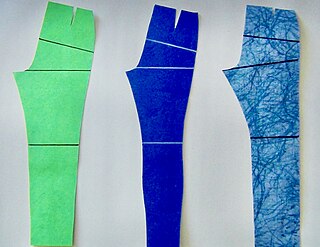
In sewing and fashion design, a pattern is the template from which the parts of a garment are traced onto woven or knitted fabrics before being cut out and assembled. Patterns are usually made of paper, and are sometimes made of sturdier materials like paperboard or cardboard if they need to be more robust to withstand repeated use. The process of making or cutting patterns is sometimes compounded to the one-word patternmaking, but it can also be written pattern making or pattern cutting.

1850s fashion in Western and Western-influenced clothing is characterized by an increase in the width of women's skirts supported by crinolines or hoops, the mass production of sewing machines, and the beginnings of dress reform. Masculine styles began to originate more in London, while female fashions originated almost exclusively in Paris.
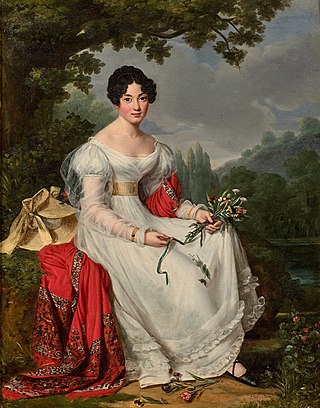
During the 1820s in European and European-influenced countries, fashionable women's clothing styles transitioned away from the classically influenced "Empire"/"Regency" styles of c. 1795–1820 and re-adopted elements that had been characteristic of most of the 18th century, such as full skirts and clearly visible corseting of the natural waist.
Sweater design is a specialization of fashion design in which knitted sweaters are designed to fulfill certain aesthetic, functional and commercial criteria. The designer typically considers factors such as the insulating power of the sweater ; the fashion of its colors, patterns, silhouette and style lines, particularly the neckline and waistline; the convenience and practicality of its cut; and in commercial design, the cost of its production and the profitability of its price point. Sweater designs are often published in books and knitting magazines. Sweater design is an old art, but continues to attract new designers such as Nicky Epstein and Meg Swansen.

A scrunchie is a fabric-covered elastic hair tie used to fasten medium to long hair types. The elastic hair tie is encased in loose fabric that forms a ruffle when twisted around a ponytail. Large, elaborate styles and diminutive, unassuming forms are available in many different colors, fabrics, and designs.

Soutache, also known as Russia braid, is a narrow flat decorative braid, a type of galloon, used in the trimming of drapery or clothing. Soutache is created by weaving a decorative thread around and between two parallel cords and completely covering the cores; this produces a piece of trim with a braided or herringbone pattern. Often woven of metallic bullion thread, silk, or a blend of silk and wool, soutache began to be made of rayon and other synthetic fibers in the 20th century.
Sewing is the craft of fastening or attaching objects using stitches made with needle and thread. Sewing is one of the oldest of the textile arts, arising in the Paleolithic Era. Although usually associated with clothing and household linens, sewing is used in a variety of crafts and industries, including shoemaking, upholstery, sailmaking, bookbinding and the manufacturing of some kinds of sporting goods. Sewing is the fundamental process underlying a variety of textile arts and crafts, including embroidery, tapestry, quilting, appliqué and patchwork.
The Singer Model 27 and later model 127 were a series of lockstitch sewing machines produced by the Singer Manufacturing Company from the 1880s to the 1960s.. They were Singer's first sewing machines to make use of "vibrating shuttle" technology. Millions were produced. They are all steel and cast iron, and were built before the advent of planned obsolescence, and so they were designed to be repaired rather than replaced. Consequently many remain today, some in collections and others still in service. In company literature they were called "the woman's faithful friend the world over".
A zigzag stitch is variant geometry of the lockstitch. It is a back-and-forth stitch used where a straight stitch will not suffice, such as in reinforcing buttonholes, in stitching stretchable fabrics, and in temporarily joining two work pieces edge-to-edge.
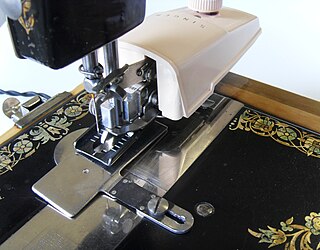
A buttonholer is an attachment for a sewing machine which automates the side-to-side and forwards-and-backwards motions involved in sewing a buttonhole.

A blind stitch in sewing is a method of joining two pieces of fabric so that the stitch thread is invisible during the normal use of the finished product. Blind stitching uses a folded edge of the fabric to hide the stitches; therefore, this type of stitch can be used to create a blind hem or to join two folded edges together.

A presser foot is an attachment used with sewing machines to hold fabric flat as it is fed through the machine and stitched. Sewing machines have feed dogs in the bed of the machine to provide traction and move the fabric as it is fed through the machine, while the sewer provides extra support for the fabric by guiding it with one hand. A presser foot keeps the fabric flat so that it does not rise and fall with the needle and pucker as it is stitched. When especially thick workpieces are to be sewn, such as quilts, a specialized attachment called a walking foot is often used rather than a presser foot.

The Singer Featherweight is a model series of lockstitch domestic sewing machines produced by the Singer Manufacturing Company from 1933 to 1968, significant among sewing machines for their continuing popularity, active use by quilters and high collector's value.
Mary P. Carpenter or Mary P.C. Hooper was an American inventor from Buffalo, New York credited with seventeen patents over her lifetime. She also founded two companies, the "Carpenter Sewing Machine Co." and the "Carpenter Straw Sewing Machine Co.".

